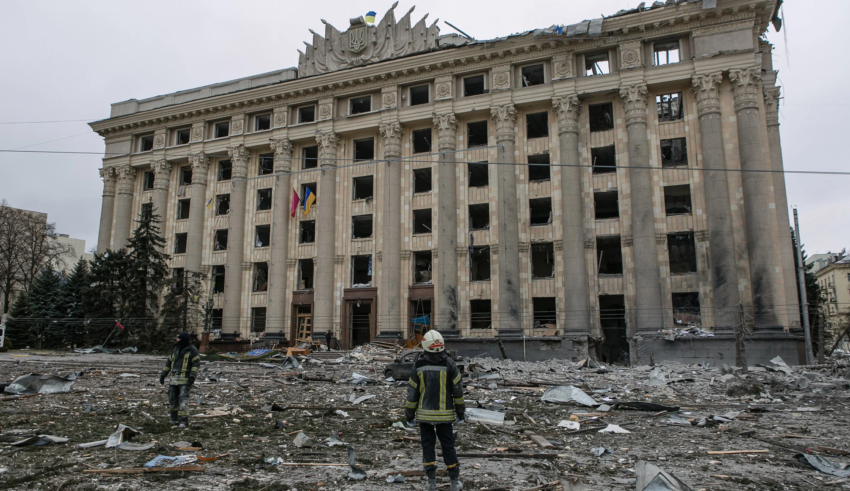
In a period of six months, since Russia’s invasion in February, UNESCO has verified the destruction of 179 cultural sites in Ukraine. As of the 19th of August, the last update of UNESCO’s list of damaged cultural sites in Ukraine includes 13 museums, 17 monuments, many religious sites, historic buildings, and almost a dozen libraries. However, according to the Deputy Minister of Culture and Information Policy of Ukraine, Kateryna Chuyeva, the problem is much bigger, verifying the damage of 492 heritage sites, objects, and cultural institutions. At the same time, the International Council of Museums in a statement published on the 19th of August on its website announced the Executive Board’s decision to establish a revised protocol that will allow the organization to address the ongoing conflicts. In the same statement, ICOM describes Russia’s destruction of Ukraine’s heritage as deliberate, taking a clear stand in favor of the Ukrainian government.
As both countries are parties to the 1954 Convention for the Protection of Cultural Property in the Event of Armed Conflict, the atrocities committed by Russia against the Ukrainian cultural heritage could be considered a war crime. Critical is whether Russian direct attacks against Ukraine’s cultural property were deliberate or can be excused by imperative military necessity, as article 4 of the Hague Convention provides. In addition, according to the Rome statute of the International Criminal Court 1999 war crimes are considered the intentional directing of attacks against civilian objects and buildings dedicated to religion, education, art, science, and historical monuments provided that they are not military objectives. The debate between the two countries remains, with Russia claiming that the destructed cultural buildings were occupied by Ukrainian troops as garrison points. However, in the case of the Ivankiv Historical and Local History Museum, an aerial view of the building shows no military presence in the era. On the contrary, only the Museum was hit while the surrounding residential buildings remain intact. Initially, at least this can be brought as a piece of evidence that the Museum was the main target of the attack and not collateral damage.
As the legal discussion over Russia’s accountability for any unwarranted destruction of Ukraine’s heritage is in the spotlight, we should not forget what in reality is under attack. The Russian invasion targets not only the Ukrainian cultural heritage but mainly the national identity and history of Ukrainians. Cultural heritage is the reflection of a nation’s past that confirms its presence and ensures its future. As Ukraine’s UN Ambassador Sergiy Kyslytsya stated during a General Assembly Emergency Special Session on Ukraine at the United Nations “If you are going to destroy the national identity you should deprive the people of their culture, particularly by destroying their heritage sites”.
Apart from the destruction of the Ukrainian immovable cultural heritage, the war has seriously impacted the movable cultural property as well. Instead of what happened in Syria and Iraq, where archaeological sites were looted on a massive scale, in Ukraine we have seen mainly thefts from museums and churches. There have been reports of 2000 stolen artworks from museums in Mariupol and Melitopol, among which are ancient Scythian gold objects that have been stolen from the Museum of Local History in Melitopol and are of great importance for Ukraine. An example of Russia’s strategic aim is the statement of the new Director of the museum, appointed by the Russians, on national television that the artifacts “are of great value for the entire former Soviet Union”, erasing any connection of the objects to the Ukrainian cultural heritage and the nation’s past.
Additionally, there are concerns that, much like what happened in the Middle East, looted and stolen cultural objects can be illegally transferred from parts of Ukraine that are Russian-occupied and used as means to financially support the war. Something similar happened in 2014 during the Russian invasion and annexation of Crimea when UNESCO expressed its concerns about the massive theft and transfer of valuable cultural artifacts from Crimean museums to Moscow. International organizations, like UNESCO and ICOM, have already taken action for the protection of the country’s movable and immovable heritage, either by monitoring destroyed sites via satellite imagery and building an evidence base of the atrocities committed or by publishing a Red List of Cultural Objects at Risk for Ukraine to fight the illicit trafficking. It is also essential for cultural heritage professionals and museums along with law enforcement agencies and customs services to increase their vigilance for looted and stolen artifacts coming from Ukraine.
By The European Institute for International Law and International Relations.















